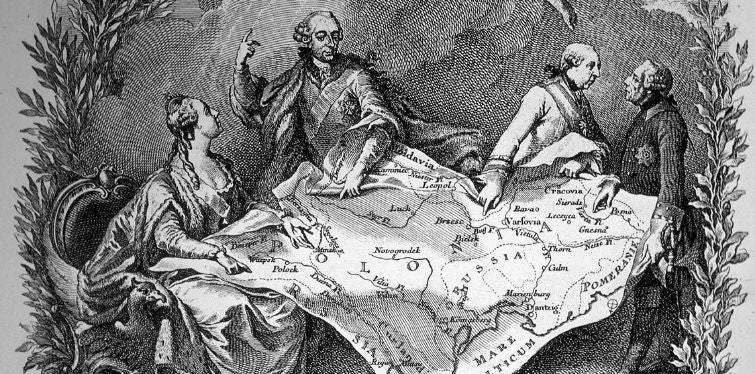This is the first instalment of a blog series looking into the experience of Poland during the Napoleonic Wars. The series will consist of a number of posts focusing on important events, developments, and individuals in Poland in the quarter century between 1790 and 1815.
It is impossible to write about Poland in the Revolutionary and Napoleonic Wars without discussing the three partitions of Poland between 1772 and 1795 which eventually led to this proud nation’s erasure from the map of Europe.
Poland-Lithuania had been one of the largest and most powerful countries in medieval Europe, but by the mid-17th century a Cossack uprising supported by Muscovy ushered in more than 30 years of political instability known as The Deluge. A brief renaissance under King John III Sobieski – best known for relieving the 1683 siege of Vienna – was not enough to arrest Poland’s decline relative to her eastern neighbour, Russia. Poland was one of the main theatres of the Great Northern War (1700-21), experiencing a protracted civil war between Swedish and Russian-backed candidates for the Polish throne.
The driving factor behind Poland’s relative decline was its political system. Polish politics was dominated by the szlachta (nobility) which limited the powers of the King through the Sejm (Parliament). Under the infamous liberum veto, any deputy of the Sejm could vote to end the ongoing session and nullify all the decisions that had been taken by the Sejm to that point. Moreover, unlike almost all its peers, the Polish crown was elective. Elections for the throne were influenced not only by shifting political alliances between powerful magnates, but also by foreign powers.
Poland’s political development stood in stark contrast to the increasing absolutism of her fellow European powers, exemplified by Louis XIV’s France and imitated by the rising eastern powers Russia and Prussia. The limited power of the King of Poland meant that he could only field an army of some 30-40,000 men, and was dependent on the goodwill of his magnates. The most powerful magnates could raise armies rivalling those of the King.
During the first half of the 18th century Poland was ruled by Saxon kings (i.e. the Electors of Saxony) who owed their election Russian military force. When King Augustus III of Poland (a.k.a. Frederick Augustus II, Elector of Saxony) died in 1763, the new Russian empress Catherine II (known to posterity as Catherine the Great) supported the candidacy of the 32-year-old Stanislaw Poniatowski.

Catherine the Great, Empress of Russia
Not only was Poniatowski from one of the most powerful noble families in Poland at the time, but he had been Catherine’s lover in St Petersburg almost a decade earlier. At that time the pair entertained the prospect of a dynastic union between Russia and Poland. Stanislaw had understood the partnership as a union of equals, but Catherine sought to ensure that Poland would be subordinate to Russia. She aimed to control Polish policy through Stanislaw to further Russian interests.
The circumstances behind Stanislaw’s election to the throne as King Stanislaw II Augustus of Poland were not free of controversy. Members of the szlachta who opposed Russia’s influence in the country sought an alternative candidate, looking for diplomatic support from France. In the event Stanislaw’s election was secured by the presence of a Russian army in Warsaw.

King Stanislaw II Augustus of Poland
Stanislaw realised that he owed his throne to Catherine and was keen to rally the whole nation behind him. An intelligent politician who corresponded with the leading Enlightenment thinkers of the day, he realised that Poland could only survive by strengthening the powers of the Crown. He worked on an ambitious programme of reforms which would centralise state administration and reform the liberum veto to prevent its use from disbanding the Sejm and annulling all the decisions it had taken. While Catherine was supportive of these reforms in principle, her Prussian ally Frederick the Great was far less enthusiastic and warned that Poland could become a threat to her neighbours. While Stanislaw was forced to scale down the ambition of his reforms, he managed to establish a state budget, increase spending on the army, and rationalise the administrative system which had duplicate offices for Poland and Lithuania.
Stanislaw’s efforts to demonstrate to his subjects that he was an independent ruler and not a Russian puppet were undermined in 1767-68, when he was forced to support Russian demands to allow Orthodox bishops to be represented in the Senate in spite of considerable internal opposition. A coalition of leading nobles (including Casimir Pulaski, who would become the father of the American cavalry) proclaimed a confederation at the fortress of Bar in opposition to Stanislaw’s pro-Russian policy. Stanislaw was forced to rely on Russian support to crush the confederates, even though he sympathised with their position. A four year war ensued, drawing in France, Russia, while Austria and Prussia helped themselves to Polish territory. The Russo-Ottoman War (1768-74) also complicated the diplomatic situation in Europe. With his hands tied fighting the confederates, Stanislaw refused to join Russia’s war against the Ottomans.
The War of the Bar Confederation weakened Poland considerably. Stanislaw’s political weakness and his independent-minded instincts prompted Catherine to reassess her policy in Poland. In order to diffuse Russia’s rivalry with Prussia and Austria, she proposed to partition Polish territory between the three powers. Despite misgivings by Empress Maria Theresa, Austria decided it could not allow moral sentiments to get in the way of policy. Frederick remarked, ‘The more she wept, the more she took.’ Under the terms of the partition, Prussia received 36,000 km² of territory with a population of 580,000, Russia 92,000 km² and a population of 1,300,000, and Austria increased her territory by 83,000 km² and population by 2,650,000. Stanislaw’s best efforts to prevent the Sejm from meeting to ratify the partition were defeated by the presence of Austrian, Prussian, and Russian troops in Warsaw.
Moreover, the Polish-Lithuanian Commonwealth was formally recognised as a protectorate of the Russian Empire. A Permanent Council, the equivalent of a Cabinet of Ministers, was established to manage day to day political affairs. By design, Stanislaw was sidelined from the body. During the subsequent twenty years of his reign, Stanislaw sought to establish his influence among the members of the Permanent Council and to pursue incremental reforms. He was torn between a pragmatic policy of staying close to Russia, and an idealistic policy of uniting the nation under stronger royal institutions, which entailed courting potential allies in the form of Prussia and Austria.
By the late 1780s, Stanislaw appeared to have established good relations with the three partitioning powers. By 1787, Russia was once again at war with the Ottomans. Stanislaw proposed a military alliance with Catherine which would protect Russia’s western flank. However, she opted for an Austrian alliance instead and her proposals to Stanislaw amounted to a force of 12,000 Polish cavalrymen under Russian command. At the same time, Stanislaw was also talking to the Prussians. In October King Frederick William offered a full alliance.
These developments reignited hopes that Poland could once again be a fully independent state. The Sejm, which had been convened on 6 October to discuss the Russian alliance, now enthusiastically backed the Prussian offer and voted to raise an army of 100,000 men. Crucially, the Sejm had been confederated and was no longer subject to the liberum veto. Stanislaw knew this would infuriate Russia and sought to regain control of the situation. However, events had overtaken him and widespread enthusiasm for the patriotic party was accompanied by an outpouring of anti-Russian sentiment throughout the country.
Russia was isolated and at war with both Sweden (1788-90) and the Ottomans, and British Prime Minister William Pitt the Younger threatened to go to war if Russia did not moderate her demands on Ottoman territory. Confident that Russia would be kept in check by the British, Stanislaw manoeuvred to support the reformers. Together with Ignacy Potocki, who represented the interests of the progressive magnates, and Hugo Kołłątaj, who relied on popular support, Stanislaw saw the perfect opportunity to achieve his lifelong ambition as King of Poland, to create a centralised and progressive nation state.
The labours of the three men culminated in a Constitution, which was passed by the Sejm on 3 May 1791. The remarkable document was the second codified constitution in history after that of the United States. Inspired both by Britain’s constitutional monarchy and by the US constitution, it created a clear separation of executive, legislative, and judicial powers, and granted political rights to all owners of property. The king’s power was strengthened and the expense of the magnates, and the liberum veto was abolished.

The Constitution of 3rd May by Jan Matejko
However, by 1792, events would now conspire against the Constitution. Catherine was increasingly anxious about the increasing radicalism of the revolution in France, and believed Poland had also been taken over by Jacobinism. Popular opinion in Britain had forced her to back down from war with Russia. Russia and the Ottoman Empire had signed the Treaty of Jassy in January, which freed her hand to intervene in Poland. Conservative magnates who had opposed the Constitution now received a favourable hearing in the Russian capital. On 27 April, a group of magnates led by Felix Potocki formed the Confederation of Targowica with Russian support.
Although voted an army of 100,000 men, Stanislaw could only field 37,000 men and appointed his nephew Jozef Poniatowski as commander-in-chief. Polish armies under Poniatowski and Tadeusz Kosciuszko, a military engineer who had served alongside Washington in the American Revolutionary War, managed to win several victories against Russian forces, most notably Poniatowski’s triumph at Battle of Zieleńce in June. However, the numerical disparity between the opposing sides could not be overcome. Stanislaw entered negotiations and was persuaded to join the Targowicans in an effort to influence them from the inside, but the attempt was forlorn. The Russians were calling the shots.
As the Targowicans hoped, the Constitution of 3 May was annulled, as were all the other reforms passed by the ‘Great Sejm’ of 1788-92. Catherine had promised Stanislaw and the Targowicans that she would not violate Poland’s territorial integrity. However, once again political considerations forced her to change her mind. She sought new territory to give to officers who had distinguished themselves in the war against the Ottomans. Meanwhile, following her defeat by the French Revolutionary Army at Valmy in September 1792, Prussia considered withdrawing from the war. Catherine decided that she would keep Prussia in the war against France by giving her another slice of Poland. Prussia repudiated the alliance with Poland and its army occupied Poland’s western provinces. The Second Partition of Poland was duly agreed between Prussia and Russia. Prussia gained another 58,000 km² including the city of Poznan, while Russia gained 250,000 km² including Vitebsk and Minsk. A Sejm was convened in Grodno in the autumn of 1793 to ratify the partition.

Kosciuszko at the Battle of Racławice
The Second Partition was a heavy blow to the King and his fellow countrymen. The Targowicans felt betrayed by Catherine, but there was little they could do. Most of the patriots had gone into exile and few remained. Against the King’s wishes, in March 1794 Tadeusz Kosciuszko declared a national uprising against the Russian presence in Poland. Recalling his experiences in North America, Kosciuszko believed that the Poles could fight and win a guerrilla war against a far more powerful adversary, just as Washington’s Continental Army had done against the British. Kosciuszko’s victory over Russian General Alexander Tormassov at Racławice in April 1794 inspired a successful uprising against the Russian garrison in Warsaw. King Stanislaw, with his power and authority severely limited, chose to back the uprising to preserve Poland’s honour.
Despite these occasional successes, Kosciuszko’s optimism was misplaced and his rebels were defeated by the Russians at Maciejowice on 10 October 1794. Heavily wounded, Kosciuszko himself fell into Russian captivity. By the beginning of November, a Russian army under Alexander Suvorov launched an assault on the Warsaw suburb of Praga east of the Vistula. The successful assault was followed by a bloody massacre as the Russian officers lost control of their rampaging troops. The subsequent Russian occupation of Warsaw spelt an end to the rebellion.

The failure of the Kosciuszko Uprising was the final nail in the coffin for Polish statehood. Prussia, Russia, and Austria met once again to carve up what remained of Poland. Prussia would receive Warsaw, Austria Krakow and Lublin, and Russia a large part of Lithuania including Vilnius. In January 1795, as discussions were underway to partition the country, King Stanislaw was forced to leave Warsaw for his palace at Grodno. In October partition was agreed and Stanislaw was forced to abdicate from a throne which no longer existed. The name of Poland was wiped from the map of Europe, and from all administrative documents.
In February 1797, the new Tsar Paul I brought the former King of Poland to St Petersburg and greeted him as a fellow monarch. Stanislaw was given the luxurious Marble Palace, but was effectively a captive. He died a year later, with Paul and his sons Alexander and Constantine among those present at his deathbed. Others around Stanislaw’s bedside were Adam Jerzy Czartoryski, already well-established in St Petersburg, and Jozef Poniatowski, who had momentarily set aside his hatred of Russia to see his uncle for a final time. Both men would play major roles in determining the future of the Polish nation.



Share and get 15% off!
Simply share this product on one of the following social networks and you will unlock 15% off!